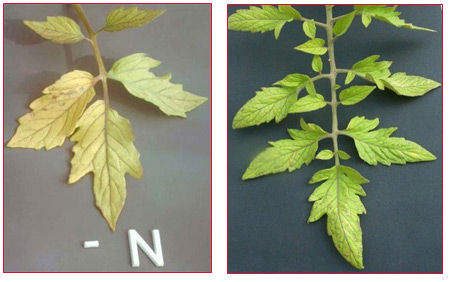Tomatoes (Lycopersicon esculentum), a summer staple in nearly every garden, are usually fairly easy to grow, even for the novice gardener. However, they can exhibit mysterious symptoms that challenge even the most experienced gardeners. Fruits, leaves or stems may become distorted or discolored, and the reasons behind the maladies can be diseases, irregular irrigation, pests or nutrient deficiencies. Tomatoes are hardy in U.S. Department of Agriculture plant hardiness zone 9 and above, but they can be grown almost anywhere during the summer months after the danger of frost has passed.

 Nitrogen deficiency may cause yellow leaves on tomato plants. The first symptoms usually affect older, more mature leaves, and gradually the yellow color progresses to more and more leaves. Young leaves tend to stay green but may be smaller in size. In some cases, a red or purple cast can be seen on the veins. Usually, applying nitrogen fertilizer helps the new growth grow normally, but already yellowed leaves will not become green.
Nitrogen deficiency may cause yellow leaves on tomato plants. The first symptoms usually affect older, more mature leaves, and gradually the yellow color progresses to more and more leaves. Young leaves tend to stay green but may be smaller in size. In some cases, a red or purple cast can be seen on the veins. Usually, applying nitrogen fertilizer helps the new growth grow normally, but already yellowed leaves will not become green.
Establishment - Promote strong early growth
Vegetative Growth - Ensure continued growth
Flowering - Fruit Set Maintain plant growth and maximize flower numbers
Fruit Ripening - Maturity In reduced amounts to maintain fruit fill
Tomato leaves turn from their normal deep green to a pale green in the early stages of nitrogen deficiency. Then, the leaves gradually turn yellow. As this happens, the veins in the leaves stay green for a while before also turning yellow. The undersides of the leaves on some plants might get red or purple. If you do not correct the situation, then the older leaves will show signs of stress quite quickly when the plant does not get enough water. Tomato plants recover quickly when you apply some nitrogen in a foliar feeding. Follow up by adding nitrogen to the soil.
Nitrogen deficiency causes plants to grow slowly and thinly. Leaf production will be sparse and what leaves there are will be stunted. A purplish tint may be present. Older leaves will yellow. Note that some tomato varieties exhibit purplish tints naturally in healthy plants. This deficiency is easily treated with fertilizer with a nitrogen component.
In the long term, mulching with organic matter (such as well rotted garden compost or manure) provides a steady trickle of nitrogen to stabilise levels. In the short term, applying high nitrogen fertilisers such as sulphate of ammonia or poultry manure pellets will remedy the problem.


Role of nitrogen in tomato plants
Establishment - Promote strong early growth
Vegetative Growth - Ensure continued growth
Flowering - Fruit Set Maintain plant growth and maximize flower numbers
Fruit Ripening - Maturity In reduced amounts to maintain fruit fill
Damage and symptoms
Cause
Nitrogen promotes green, leafy growth and deficiency results in yellowing and stunted growth. Nitrogen is very soluble, so is easily washed out of the soil in winter rains, leaving the soil deficient in spring, just when plants are putting on new growth. Nitrogen deficiency is a common cause of yellow leaves in spring.
Remedy
Follow these steps to treat nitrogen deficiency in tomato plants:
- Test the soil components. Having your soil tested is important to confirm nitrogen and other nutrient deficiencies as well. You can get a soil test kit at your local garden center.
- Determine what type of plants have nitrogen deficiency because this will determine the course of treatment. Be sure to follow the treatment plan for the type of plants affected.
- Apply nitrogenous fertilizer to your vegetable plants as a side dressing. This may help increase your yield and avoid fertilizer burn.
- Integrate nitrogen-rich fertilizer into the soil where you'll plant your vegetables the following spring as well. Choose a well-balanced fertilizer such as "Tomatoes Alive" by Gardens Alive, which has the added benefit of being an organic fertilizer.
- Try applying well-rotted manure to your garden bed as well, which tends to be nitrogen rich. You may also use any fertilizer that has nitrate, ammonium or urea in the formulation.
Tidak ada komentar:
Posting Komentar